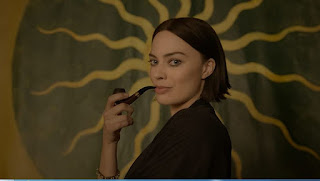James Ellroy and the Meta-narrative of the Black Dahlia Case’ in Cross-Cultural Connections expands to include new research. Ellroy’s attempts to control the Black Dahlia narrative by tying the story inextricably to his own experiences and his Demon Dog of American Crime Fiction persona began to fall apart when he became involved with two historical researchers on the Dahlia case, Larry Harnisch and Steve Hodel. There have been multiple true-crime books published about the Black Dahlia case, all written with the intention of doing what the LAPD could not: solve the case (or exploit the case's interest). For many years after the publication of The Black Dahlia, Ellroy did not comment on any of the Dahlia theories, as he seemed content with his fictional portrayal of the case. Ellroy’s first public endorsement of the work of a Dahlia researcher marked a distinct change in attitude from the novelist, and came in the documentary James Ellroy’s Feast of Death, where Ellroy endorsed Los Angeles Times reporter Larry Harnisch’s theory that the LA-based surgeon Dr Walter Bayley murdered Elizabeth Short. Ellroy did not take his endorsement of Harnisch’s work much further. Elements of Harnisch’s theory faintly echoed the narrative of The Black Dahlia, which may have appealed to Ellroy. According to Harnisch, Dr Bayley was in a state of mental decline at the time of the murder and died shortly thereafter: his personal and professional life was falling apart, and Elizabeth Short inadvertently reminded him of a family tragedy which sparked a homicidal reaction, all of which would have been familiar to Ellroy and the connections he weaved between the Sprague family and the Dahlia murder. It would not be until the publication of Steve Hodel’s Black Dahlia Avenger (2003) that the remarkable parallels between fiction and reality in Ellroy’s work would emerge. Steve Hodel was completing the research and writing on the ‘Aftermath’ chapter for the paperback edition of Black Dahlia Avenger, and Ellroy asked to see the new material. Ellroy later commented that he had been ‘unconvinced’ by Hodel’s theory when he first read the hardcover edition. Hodel requested that Ellroy provide a blurb for the new edition, but Ellroy responded with an offer to write the foreword.
Hodel said: ‘to his credit, Ellroy never claimed his novel was anything other than “pure fiction.”’ Then Hodel hypothesized that George Hodel’s friend and criminal accomplice Fred Sexton was a plausible suspect in the murder of Ellroy’s mother. For Ellroy the murder of his mother and Elizabeth Short had always been symbolically linked, but now he had been confronted with the second true-crime writer to claim the cases were factually connected through the same murderer – a serious blurring of the line between fact and fiction that Hodel claimed had been the source of his initial reservations about Ellroy’s work. Ellroy expressed his opinion of this element of Hodel’s theory in no uncertain terms: ‘Bullshit, bullshit, just bullshit, and I told Steve that. Just bullshit.’ As Ellroy was beginning to distance himself from the work of Harnisch and Hodel, unsurprisingly, both true-crime writers expressed some degree of regret over Ellroy’s endorsements, with Harnisch commenting, ‘James Ellroy’s various endorsements have more to do with Ellroy’s well-established hunger for publicity rather than genuine support of any particular theory’ (Harnisch 2010). Hodel was rather less critical: ‘I know for a fact that James truly regrets writing the Foreword to my book. However, I suspect that his real regret is coming not so much from the heart, but rather from Ellroy, the businessman. And, believe me James is first and foremost - a businessman. His business is the promoting and marketing of James Ellroy, and he is very good at it’ (Hodel 2010).Through his involvement with Harnisch and Hodel, Ellroy realized he had lost his prominence in the Dahlia narrative. In terms of his authorial control, the least successful was the debacle of the Harnisch/Hodel affair, and it was during this period that Ellroy made repeated comments about ending his involvement with the Dahlia legacy. ―Love Me Fierce In Danger: The Life of James Ellroy (2023) by Steven Powell
Larry Harnisch (March 2, 2023, IG @lmharnisch): "I don't know what James Ellroy says about me and frankly I don't give a shit either; let me put it this way: there's a new biography of James Ellroy out and I refuse to buy it, but the book says that I complained bitterly that Ellroy drops all his friends which he does so yeah to me James Ellroy is an over the hill writer who keeps writing racist, sexist crap. In real life if you are buddies with James Ellroy, he thinks he is the greatest writer ever. I mean the guy has a phenomenal ego. I worked at the LA Times, I worked in a building full of good writers; a lot of them were better than Ellroy. I was a copy editor at the LA Times and here's this high school dropout James Ellroy schooling me on how to speak and use his Hipster language, the jive talk that he does all the time. And every fifth sentence is about his manhood, you know it's how prodigious it is, how massive it is; he's always talking about it, you would not believe how much... and to me, somebody who has to talk that much about it, he has a problem. So that's kind of my thing with Ellroy. I know there is a new biography out of him. I'm never buying it in any bookstore. I might thumb through it but sure as heck I will never buy it."


.jpg)


























.jpg)




































